Kazan Arena: FC Rubin Kazan
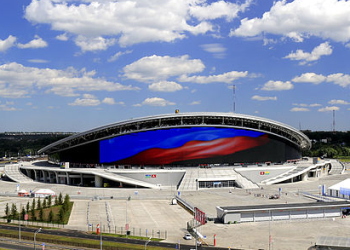
By Stanislavgubaydullin (Own work) [CC BY-SA 3.0], via Wikimedia Commons
In December 2010 it was confirmed that Russia would be the host nation for the 2018 World Cup finals. Amongst numerous issues about that decision was one particularly stand-out one: Russia didn’t have a huge amount of appropriate stadiums that could be used for the tournament. Numerous new stadiums were immediately planned, with Rubin Kazan’s new ground already in the building phase.
The stadium, built in the capital of the Tatarstan region, had gone under construction in May of 2010 and was completed in July of 2013. That was because Kazan had been chosen to host the 2013 Summer Universiade, which is essentially like the Olympics for students. The ground hosted the competition’s football matches and in 2015 it was also the venue for the 2015 World Aquatics Championships and the 2017 Confederations Cup.
Although officially known as the AK Bars Arena, it is still referred to as the Kazan Arena, even on their own website.
Stats
| Kazan Arena Stats | |
|---|---|
| Year Opened | 2013 |
| Capacity | 45379 |
| Average Attendance | 11871 |
| Record Attendance | 42951 (Rubin Kazan v Liverpool (2015)) |
| Pitch Size | 105 x 68 (7140) |
| Clubs Hosted | Rubin Kazan |
| First Fixture | Rubin Kazan v Locomotiv Moscow (17/08/2014) |
| Rubin Kazan Stats | |
|---|---|
| Year Founded | 1958 |
| Nickname | atáry (Tatars), Volzháne (People from Volga), Kamni (Stones) |
| Club Mascot | HKHX |
| Rivals | Krylia Sovetov, KAMAZ, Amkar |
| Previous Stadiums | Rubin Stadium |
| Kit | Red (Home) / Green (Away) / White (Third) |
| Training Ground | Rubin Stadium |
| Shirt Sponsor | тAиф |
| Team Owner | Tatarstan |
Kazan Arena Photos
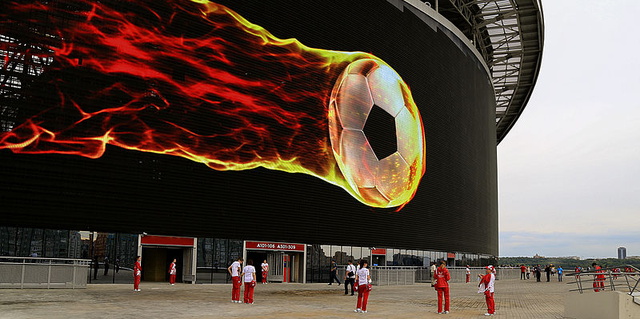
By Stanislavgubaydullin (Own work) [CC BY-SA 3.0]
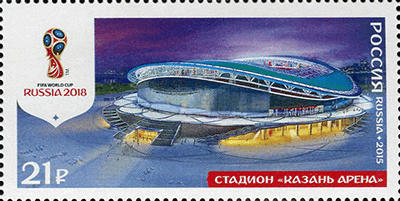
By Stamp issuing authority - MARKA Publishing & Trading Centre. Printer - Association GOZNAK of the Ministry of Finance of the Russian Federation [Public domain]
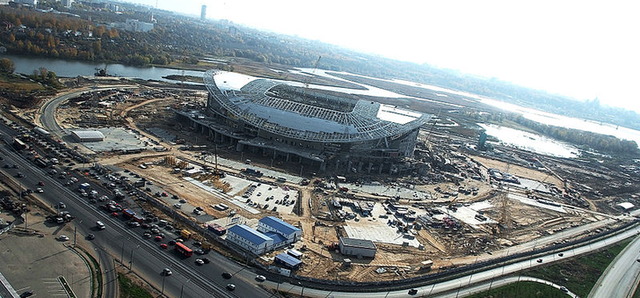
By Stanislavgubaydullin (Own work) [CC BY-SA 3.0]
Kazan Arena Seating Plan and Where to Sit
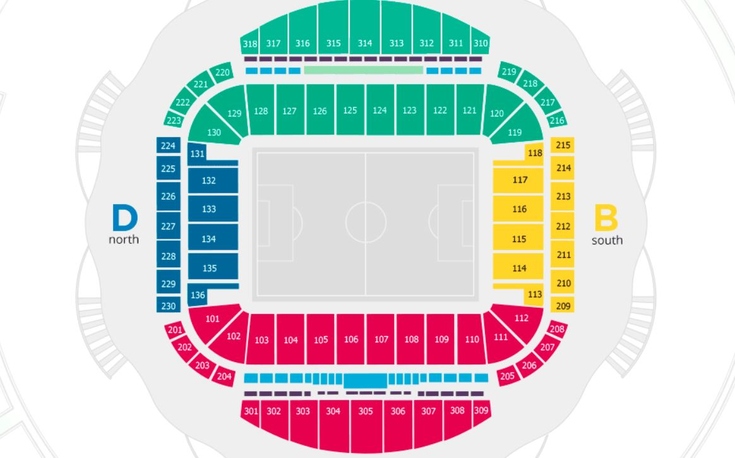
The Kazan Arena looks quite large on first viewing but there’s actually an awful lot of wasted space. The North and South Stands are behind the goals and are two-tiered affairs. The East Stand follows a similar pattern, whilst The West Stand has three tiers thanks to an executive section in the middle.
Rubin Kazan Ticket Prices
Ticket prices for Rubin games will alter depending on where in the ground you’d like to sit. The ends of the stadium tend to be cheaper than the sides, with tickets in the North and South stands setting you back between ₽300 and ₽400r. Tickets in The East Stand range from ₽350 – ₽500r, whilst The West Stand is the most expensive part of the ground and ticket cost between ₽500 and ₽1200r to sit there.
How To Get Rubin Kazan Tickets
Tickets can be bought online but you really do need to have a passable knowledge of the Russian language to pull that off. Alternatively you can buy them in person from the club’s ticket office before the game kicks off.
Where to Buy
Getting To Kazan Arena
Kazan is in the South-West of Russia, not too far from the borders with Ukraine, Kazakhstan and Georgia. It’s still quite a distance from the UK, though, so you’ll have a heck of a journey on your hands to get there. Here are some methods and routes to consider:
Train – A train from London St. Pancras International to Kazan will take you just under two and a half days and will go via Paris, Strasbourg and Moscow. Once you’re in the city you’ll want to take Trolleybus 7 or trams 5 or 6 to get to the ground, with Football Stadium Kazan Arena being about five minutes from the ground. Gavrilova is about ten minutes away.
Bus – Buses 1, 7, 10a, 18, 33, 35, 35а, 36, 44, 45, 46, 49, 55, 60, 62 and 76 will all take you to the ground from the centre of Kazan.
Car – Take the Yamashev Avenue to the Yamashev-Chistopolskaya interchange. From there take Chistopolskaya Street and you’ll see the ground on your left. Alternatively you can essentially follow Chistopolskaya Street from the city centre if you’ve been on Amirkhana Avenue.
By Air – Kazan International Airport is, as the name suggests, the closest to the city. It’s about 30km away from the centre of the city and there’s an Aeroexpress that can take you to Kazan Station.
Taxi – A taxi from the airport to the ground will set you back by about 600 rubles, whilst a taxi from the train station to the ground will take around twenty minutes and should cost something like 200 rubles.
Parking Near Kazan Arena
There is a parking lot at the stadium where you can leave your car.
Useful Resources
Kazan Arena Hotels
The nicest part of Kazan is to the South-West of ground on the far side of the Kazanka River. That’s where you’ll find the sort of hotels whose names you recognise, though they may not be the cheapest in the area:
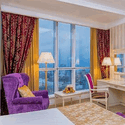
Korston Tower - £50+
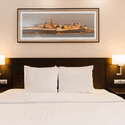
Courtyard by Marriott Kazan Kremlin - £60+
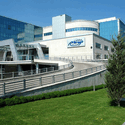
Mirage Hotel - £70+
Pubs and Bars Near Kazan Arena
The best place to go for a pre-match pint is the same sort of area that you’ll find the best hotels. Here are some of your top choices:
Trinity Irish Pub
Irlandskiy Pab Dublin
Coyote Ugly
Facilities
Despite only opening in 2013 Kazan Arena was one of the oldest grounds to be used for the 2018 World Cup which was held in Russia. That doesn’t mean that it’s a scruffy and unwelcoming place, however. Even today it is still comparatively new and fresh and is one of few stadiums in Russia that is actually heated. A nice place to go and watch a game of football or two.
Hospitality
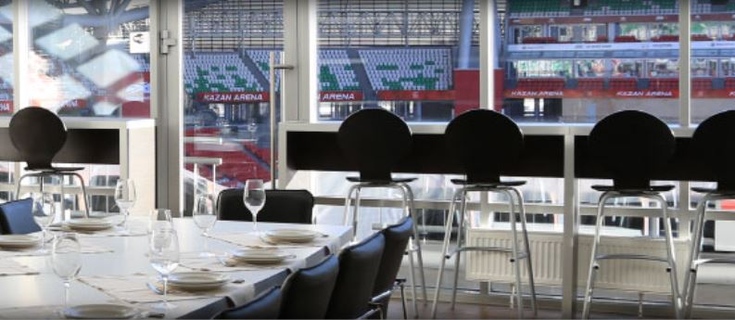
The stadium features a number of Skyboxes that can be hired for all of your hospitality needs. There are 72 of them in total and offer maximum comfort and enjoyment. Hospitality packages include a VIP space with a panoramic view of the pitch, food and drink served to order and a private entrance into the ground.
Private Hire
The Skyboxes are not just for those wishing to indulge in a bit of VIP experience for football matches. They are all available for private hire for business meetings, presentations, negotiations and more. If you have a private hire need then the Kazan Arena will be an impressive location for your event.
Stadium Tours & Museum
Tours of the stadium take in all of the sights that you’d expect, including the changing rooms, the dugouts and the pitch side area. You can also have a wander around the stands themselves and pick your favourite spot for a match day. They last an hour and it will cost you ₽350 rubles if you’re an adult and ₽300 rubles for students, children and OAPs.
About Rubin Kazan

The story of Rubin Kazan has been one of a club enjoying a relatively rapid rise to success. The club wasn’t founded until 1958 and didn’t make the top-flight of Russian football until 2003. They didn’t mess about once they got there, though, winning the Russian Premier League in successive seasons in 2008 and 2009. In 2012 they won the Russian Cup and they have also established themselves as regular competitors in both the Champions League and the Europa League.
Between the club being founded in 1958 and 1964 it was known as Iskra and from 1992 until 1993 it was called Rubin-TAN. In 1996 Rubin Kazan was bought by the city’s mayor at the time, Kamil Iskhakov. He helped to sort out the club’s finances and then set them the aim of getting into the Premier League. From 2003 until 2009 there was major upheaval with the squad as Kazan became a true force in Russian football.
Kazan Arena History
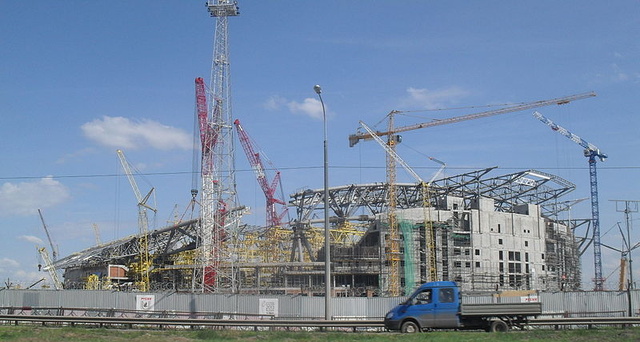
The Kazan Arena has a true claim to fame: It has the largest outdoor screen in all of Europe attached to it. Past that, most of the stadium’s more exciting stories are yet to be written. The building of it was completed in 2013 and it has generally been used to host football matches, especially those of Rubin Kazan. Perhaps the most exciting thing so far happened in 2015 when it was the venue for the World Aquatics Championship. The entire pitch was taken up and replaced with a swimming pool for the diving competition and more.
The stadium was used as a venue for the 2017 FIFA Confederations Cup and then was one of the locations for the 2018 FIFA World Cup. It hosted one of the semi-final matches of the Confederations Cup, which will have acted as a good preparation for the World Cup. In football’s greatest tournament Kazan Arena was used as the location for a quarter-final stage game between Belgium and Brazil where plucky little Belgium actually defeated the Brazilian team much to everyone’s surprise.
Designed by the architectural firm Populous, the stadium is a response to the unique culture and life of the city of Kazan itself.
Future Developments
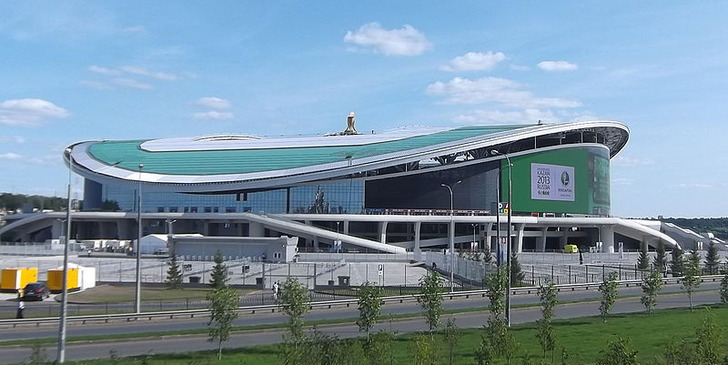
As a relatively new stadium there are unlikely to be any major developments to the ground in the near future. That said, small cosmetic and structural changes may be put in place to ensure that it’s kept up to date.
